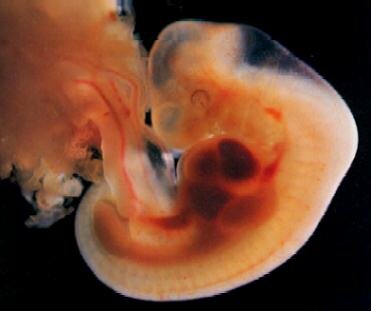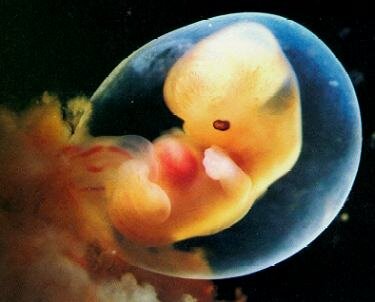In a dispute about whether death is a cessation of breathing or a cessation of the heartbeat, the Talmud suggests that a parallel may be drawn to another dispute, this one concerning the growth of a human embryo:
יומא פה, א
נֵימָא הָנֵי תַּנָּאֵי כִּי הָנֵי תַּנָּאֵי. דְּתַנְיָא: מֵהֵיכָן הַוָּלָד נוֹצָר — מֵרֹאשׁוֹ, שֶׁנֶּאֱמַר: ״מִמְּעֵי אִמִּי אַתָּה גוֹזִי״, וְאוֹמֵר: ״גזִּי נִזְרֵךְ וְהַשְׁלִיכִי״. אַבָּא שָׁאוּל אוֹמֵר: מִטִּיבּוּרוֹ, וּמְשַׁלֵּחַ שָׁרָשָׁיו אֵילָךְ וְאֵילָךְ
Let us say that the dispute between these tanna’im who disagree about checking for signs of life is like the dispute between these tanna’im who disagree about the formation of the embryo. As it was taught in a baraita: From what point is the embryo created? It is from its head, as it is stated: “You are He Who took me [gozi] out of my mother’s womb” (Psalms 71:6), and it says: “Cut off [gozi] your hair, and cast it away” (Jeremiah 7:29). [These verses suggest that one is created from the head, the place of the hair.] Abba Shaul says: A person is created from his navel, and he sends his roots in every direction until he attains the image of a person.
So today we will discuss Talmudic embryology, and focus on the question of how, exactly, the growing embryo forms.
Let’s start with a passage found in the tractate Niddah, that beautifully describes the way a growing fetus lays within the womb.
נדה ל, ב
דרש רבי שמלאי למה הולד דומה במעי אמו לפנקס שמקופל ומונח ידיו על שתי צדעיו שתי אציליו על ב' ארכובותיו וב' עקביו על ב' עגבותיו וראשו מונח לו בין ברכיו ופיו סתום וטבורו פתוח ואוכל ממה שאמו אוכלת ושותה ממה שאמו שותה
Leonardo Da Vinci. Studies of the Fetus in the Womb. Drawn between 1510-1513.
R. Simlai delivered the following discourse: What does an embryo resemble when it is in the bowels of its mother? Folded writing tablets. Its hands rest on its two temples, its two elbows on its two legs and its two heels against its buttocks. Its head lies between its knees, its mouth is closed and its navel is open, and it eats what its mother eats and drinks what its mother drinks...
Talmudic embryology reflected the prevailing Greek theories of the times. But those theories developed without the benefit of microscopes and the other tools later available to scientists. Despite this, sometimes the rabbis of the Talmud were spot on with their embryology. The statement of Rav Simlai is a good example. (He lived in 3rd century CE, and is the rabbi who brought you the famous count of 613 commandments.) It is a perfect description of a growing fetus, written as if Rav Simlai was looking at Leonardo Da Vinci’s famous sketch. But his was not the only talmudic description of a how a fetus grows, so let’s look at some others.
Will the real Abba Shaul please stand up?
As we read on this page of Talmud, Abba Shaul declared that the fetus grows from its navel:
יומא פה,א
מהיכן הולד נוצר מראשו וכן הוא אומר ממעי אמי אתה גוזי ואומר גזי נזרך והשליכי וגו' אבא שאול אומר מטיבורו ומשלח שרשו אילך ואילך
From where is the embryo formed? From its head, as the verse says (Ps.71:6): "From my mother's womb you pulled me out (gozi)". And it says later (Jeremiah 7:29) "Pull out (gozi) your hair and throw it away.." Abba Shaul says that the fetus is created from its navel, and from there it sends out roots in all directions.
But elsewhere Abba Shaul has a different theory:
נדה כה, א
אבא שאול אומר תחלת ברייתו מראשו
Abba Shaul says: The beginning of the formation of the embryo is from its head
The contradiction between these two statements was noted by the great French medieval commentator Yakov ben Meir, known as Rabbenu Tam (d. 1174). He suggested that there is an error in the text before us: In Niddah, it should not read “from its head (מראשו), but “like a locust” (כרשון). Indeed this is the reading found in the important medieval dictionary Sefer HaAruch and echoed centuries later in Marcus Jastrow’s dictionary.
תוספות נדה כה,א, ד’ה תחלת ברייתו מראשו
תימה דבפ' בתרא דסוטה (דף מה:) קסבר אבא שאול תחלת ברייתו מטיבורו ומשלח שרשיו אילך ואילך ונראה לר"ת דגרס כרשון וכן פר"ח ובתוספתא פירש כעין חגב דסלעם מתרגמינן רשון וכן משמע דמיירי בשיעור האברים
Rabbenu Tam’s explanation makes a great deal of sense and leaves Abba Shaul with only one opinion: the fetus develops from the navel. This is not exactly what actually occurs, but to the naked eye it is not too far from it. Interestingly, Maimonides declined to take a position on the matter, and wrote simply that “at the beginning, the body of a person is the size of a lentil…”(תְּחִלַּת בְּרִיָּתוֹ שֶׁל אָדָם גּוּפוֹ כַּעֲדָשָׁה).
“The Talmudic Sages,being true polyhistors, took into account experimental biology as well as popular beliefs.”
Embryonic Development in Antiquity
In 1934 the British historian and embryologist Joseph Needham published A History of Embryology, in which he traced theories of embryonic development from from antiquity to modern times. In this fascinating book we learn that Hippocrates (c. 460-370 BCE) believed the fetus was formed by extracting breath from its mother, and that a series of small fires within the uterus gave rise to the bones and other organs of the embryo. According to Needham, Aristotle (384-322 BCE) understood that the role of the umbilicus was to nourish the fetus. The vessels of the umbilicus join onto the uterus like the root of a plant and through the cord the fetus receives its nourishment. Elsewhere, Aristotle claimed (contra Abba Shaul) that head of the fetus forms first. Galen (c. 129-216 CE) also used the analogy of the umbilicus serving like the root of a plant. According to him the embryo grew from menstrual blood, and then from the blood that nourished it through the umbilical cord.
What Actually Happens -not from THE head or from the navel
Development of the Umbilical cord. A: The posterior body wall is established. B: the vitelline duct form as the cells form a head and tail end, fold inwards on their lateral sides. C: The umbilical cord forms as the yolk sac and vitelline duct fuse. From O'Donnell K. Glick P, Caty M. Pediatric Umbilical Problems. Pediatric Clinics of North America. 1988 24 (1) 792.
At its earliest stage the embryo consists of a sheet of cells, an amniotic cavity and a yolk sac. The sheet of cells develops a head (cranial) and bottom (caudal) end, and grows around most of the yolk sac. This enclosed yolk sac then grows into the gut of the embryo. The part of the yolk sac that is not surrounded by the embryo is still connected to it by a thin tube called the vitelline duct. This duct then fuses with the contained yolk sac, and forms a larger bundle of vessels we call the umbilical cord. This occurs between the 4th-8th week of gestation (calculated from the first day of the last menstrual cycle).
It is clear then, that the embryo does not grow from the head or from umbilical cord. As you can see from the diagram, the head develops from the early cells of the embryo as it takes on a cranial-caudal polarity, sometime around 3-4 weeks gestation, when the embryo is about 3mm in length. Neither does the embryo grow from the umbilical cord, as Abba Shaul claimed. In fact it is the umbilical cord that grows out from the early embryo, and not the other way around.
However well understood the process of fetal development may now be, pregnancy remains a time that is often fraught with uncertainty and insecurity. The rabbis of the Talmud articulated these fears with a prayer, that reminds us of the fragility of human development and the relief when it all goes well.
ברכות ס,א
שלשה ימים הראשונים יבקש אדם רחמים שלא יסריח משלשה ועד ארבעים יבקש רחמים שיהא זכר מארבעים יום ועד שלשה חדשים יבקש רחמים שלא יהא סנדל משלשה חדשים ועד ששה יבקש רחמים שלא יהא נפל מששה ועד תשעה יבקש רחמים שיצא בשלום
During the first three days after intercourse, one should pray that the seed not putrefy, [that it will fertilize the egg and develop into a fetus].
From the third day until the fortieth, one should pray that it will be male.
From the fortieth day until three months, one should pray that it will not be deformed, in the shape of a flat fish,
From the third month until the sixth, one should pray that it will not be stillborn.
And from the sixth month until the ninth, one should pray that it will be emerge safely.









